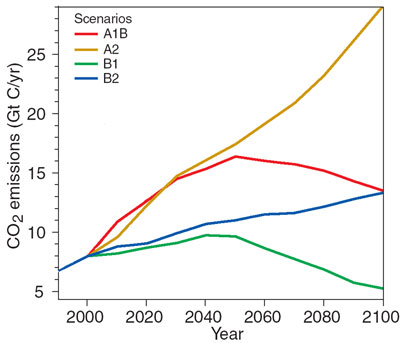|
|
 |
|
|
|
 |
| |
|
|
 |
How are
people changing
the climate?
Read more |
2. What will
a warmer world be like?
Future emissions
and climate change
The future climate will be determined partly by how much greenhouse gases we emit, which is in turn determined by future developments in the economy, technology, and population growth. Population size, affluence, fossil fuel consumption, and energy efficiency all have tremendous influence on how big our emissions will be. |
|
|
|
|
 |
Driving forces
- Population size. Each person has a pattern of consumption – from the food we eat, the cars we drive, etc. – that results in emissions of greenhouse gases. The more people who live on the Earth, the greater the emissions. The emissions increase the most if the population increases in rich areas of the world.
- Affluence. The wealthier we are, the more we consume, and the bigger our emissions are.
- Consumption of fossil fuels. Fossil fuels emit greenhouse gases, while renewable sources of energy, such as wind energy or solar power, do not give off such emissions. The kind of fossil fuels we burn also matters. Coal power gives off greater emissions of CO2 than does power from natural gas.
- Energy efficiency. New technologies can allow us to use energy more effectively. Thus in the future we are likely to need less energy to produce goods or services. Today, a car uses between about one liter and half a liter of gasoline to drive 10 kilometers. Cars used to need more fuel than that; in the future, we expect engines to become even better at saving fuel.
Scenarios
We cannot know for sure how these driving forces of climate change will look in the future – but we can guess. Scientists at IPCC have constructed four very different pictures of the future, or scenarios as they are also called, to represent changes in population size, affluence, use of energy sources, and energy technology up to the year 2100. All four scenarios describe a possible future development:
A1B – a rich world
A world with very rapid economic growth, low population growth, and a rapid introduction and application of new and more effective technology.
A2 – a heterogeneous world
A world with a large gap between the rich and the poor, high rates of population growth, and slower economic development. Distribution of new technology is slow, and energy needs are largely met through fossil resources.
B1 – a sustainable world
A world with rapid changes. Concern for the environment will stimulate development of new technologies to avoid using fossil resources. New technology is developed and spread quickly, and efforts are made to close the gap between rich and poor and create a more environmentally sound economy. |
B2 – a technologically imbalanced world
A world with emphasis on local solutions for economic, social, and environmental sustainability. In some areas, technology will develop rapidly, while other areas will be forced to make do with outdated technology.
|
 |
 |
 |
|
How CO2 emissions might develop over the coming century, according to four different scenarios. Adapted from IPCC. (click to enlarge, 60 kB)
|
|
|
For each of these very different future scenarios, scientists have estimated what the emissions would be. These emissions figures are then entered into climate models to calculate how the concentrations of greenhouse gases, temperature, sea level, and climate will be changed in each of the scenarios.
These scenarios are what the IPCC used to come up with the figure of a temperature increase between 1.4 and 5.8°C by the year 2100. To ensure that all reasonable future developments have been taken into account, they have used about 40 variations of the four scenarios – where they made smaller changes in the demographics, economic growth or energy consumption estimates, and used different economic models. The reason for the large difference between the highest and lowest temperature estimates is partly that there is some uncertainty about how exactly the climate system works, and partly that we cannot know precisely what the future holds in terms of social developments and emissions patterns. The IPCC says that for every emissions scenario there is a 40% chance that the temperature change will be greater than indicated, but only a 5% likelihood that it will be less.
These scenarios do not take into account the possibility of countries implementing new, comprehensive measures for reducing emissions of greenhouse gases. If that happens, then both the emissions and warming can be reduced.
|
|
Back to Basics-section
Author: Camilla Schreiner - CICERO (Center for International Climate and Environmental Research - Oslo) - Norway. Scientific reviewers: Andreas Tjernshaugen - CICERO (Center for International Climate and Environmental Research - Oslo) - Norway - 2004-01-20 and Knut Alfsen - Statistics Norway - Norway - 2003-09-12. Educational reviewer: Nina Arnesen - Marienlyst school in Oslo - Norway - 2004-03-10. Last update: 2004-03-27.
|
|
 |
|









